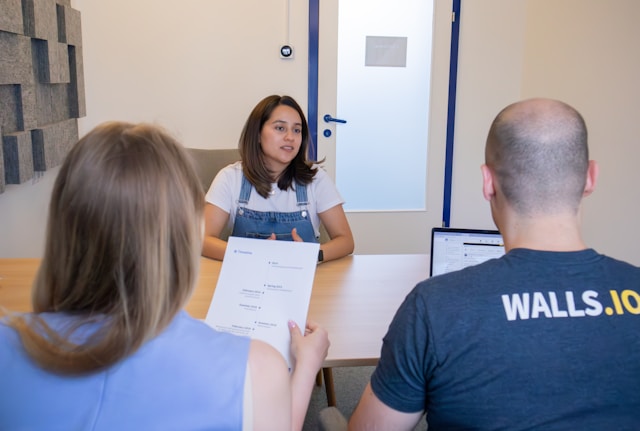Best AI Recruiting Tools for Streamlining Hiring in 2025

Have you ever wondered how much easier hiring could be with the right tools?
Finding the best AI recruiting software can completely change how you manage hiring. These tools handle time-consuming tasks like screening resumes, scheduling interviews, and engaging candidates, helping you save hours while reducing bias.
And here’s the best part: whether you’re filling just a few roles or scaling to dozens, automated platforms like HRMLESS work around the clock to keep your pipeline moving. With 24/7 AI interviews, instant candidate scoring, and SMS/email nudges, you keep the process flowing smoothly, without adding more to your plate.
AI hiring technology is advancing quickly, but choosing the tool that truly fits your workflow makes all the difference.
In this blog, you will learn:
- Which AI recruiting tools deliver the most value in 2025
- Key features that cut hiring time and reduce ghosting
- How HRMLESS compares with other leading platforms
Let’s break down the options and see how automation can make your recruiting faster, fairer, and less stressful.
What Are AI Recruiting Tools?
AI recruiting tools automate many hiring tasks to save time and improve candidate selection. They handle everything from sourcing and screening candidates to scheduling interviews and engaging applicants. These tools help you find the right talent faster, reducing errors and bias.
Core Features of AI Recruiting Software
AI recruiting software includes features that simplify your entire hiring process. Common tools are:
- Automated Screening: Quickly filter resumes to highlight top candidates based on skills, experience, or keywords.
- Pre-Screening Interviews: AI conducts initial interviews anytime, so candidates complete them on schedule.
- Scoring and Ranking: Candidates get scored automatically, helping you focus on the best fits for your roles.
- Scheduling Automation: Your candidates can book interviews automatically, reducing no-shows and saving time.
- Candidate Engagement: SMS and email nudges keep applicants interested and informed throughout hiring.
- ATS Integration: Connects seamlessly with your existing applicant tracking system, avoiding extra steps.
These features work together to speed your hiring and reduce stress. It becomes easier to manage many openings at once.
How AI Differentiates From Traditional Recruitment
Traditional recruitment relies on manual work for tasks like resume screening, interview booking, and follow-ups. This takes time and is prone to human bias and mistakes that can slow down hiring or lead to poor hires. AI recruiting tools change that by automating repetitive tasks and making objective decisions based on data. They reduce bias by using consistent criteria for screening and scoring candidates.
You’ll save hours that usually go into manual sorting and scheduling. Also, AI tools can work around the clock. Your candidates can complete AI interviews anytime without waiting for a recruiter’s availability. This means faster candidate responses and less ghosting.
Top AI Recruiting Tools in 2025
You want tools that save time, screen candidates well, and fit your budget. The best AI recruiting platforms offer clear features and flexible pricing. User feedback highlights ease of use and real benefits in hiring quality candidates.
Comparing Leading Platforms
Top platforms focus on automating key tasks like pre-screening, scoring, and scheduling to reduce your workload. The strongest tools integrate smoothly with Applicant Tracking Systems (ATS) for better workflow.
Here’s a quick comparison:
Platform
Core Strengths
ATS Integration
AI Interviewing
Scheduling Automation
HRMLESS
Conversational AI interviews, scoring, 24/7 candidate screening
Yes
Yes
Yes
Platform B
Advanced analytics, candidate sourcing
Yes
No
Partial
Platform C
Automated outreach, resume parsing
No
No
Yes
Our tool stands out by fully automating conversational interviews and scheduling. This focus helps you reduce no-shows and screen more candidates without extra effort.
Standout Features of Each Solution
Each AI recruiting tool has unique features designed to streamline hiring:
- HRMLESS: Offers AI-driven conversational interviews 24/7, automated scoring highlighting top talent, and SMS/email engagement to keep candidates responding.
- Platform B: Focuses on deep analytics and sourcing candidates across multiple job boards to improve talent pools.
- Platform C: Specializes in automatic outreach and candidate resume parsing, speeding up initial screening, but lacks AI interviews.
Look for features that save you time, like automated scheduling and scoring. Tools that integrate well with your current ATS also cut down manual work.
Pricing and Subscription Models
AI recruiting tools come with varied pricing structures tailored to different business sizes:
- HRMLESS: Offers tiered plans, Launch (for small teams), Growth (scaling teams), and Enterprise (large volume hiring). All include core AI interviews, with advanced SMS engagement in higher tiers.
- Platform B: Charges based on the number of job postings and users, with add-ons for analytics.
- Platform C: Uses a flat monthly fee but limits AI features to basic resume parsing.
Many providers offer free trials or demo periods. Choose a pricing plan that aligns with your hiring volume and desired automation level. Transparency in pricing helps avoid surprises and ensures your ROI.
User Reviews and Testimonials
Users appreciate tools that are easy to adopt and deliver measurable results.
- HRMLESS users report a 62% reduction in time to hire and a 50% decrease in no-shows thanks to automated scheduling and candidate engagement.
- Other platforms receive praise for strong sourcing capabilities but often have steeper learning curves or limited AI interview features.
- Some customers highlight better candidate experience and fairness where tools use unbiased AI screening methods.
Look for verified reviews that mention how tools fit into daily workflow and support hiring goals. Tools that combine automation with candidate-friendly features tend to score highest in user satisfaction.
Key Benefits of Using AI in Recruitment
Using AI in recruitment helps you find better candidates faster while making the process fairer and less biased. It handles many time-consuming tasks so your team can focus on hiring quality talent efficiently.
Improved Talent Sourcing
AI recruiting tools scan large pools of candidates to find those who best match your job opening. You don’t miss out on qualified people because of a limited manual search.
These tools analyze resumes and online profiles to rank candidates based on skills, experience, and other key factors. This targeted sourcing saves you time and increases your chances of hiring the right person.
With platforms like ours, you can automate this process and instantly engage top talent. Automated outreach keeps candidates interested and ready to move forward.
Bias Reduction in Hiring
AI uses data-driven methods to reduce human bias in recruitment. It focuses on qualifications and experience rather than factors like gender, age, or ethnicity, helping you build a more diverse team. Automating scoring and pre-screening eliminates subjective judgments during early selection stages, ensuring candidates are evaluated fairly on relevant skills and fit.
Using no-bias recruitment software improves fairness and protects your company’s reputation. It helps avoid costly mistakes and legal issues related to discrimination while supporting your diversity goals.
Faster Candidate Screening
AI speeds up screening by automating resume review, pre-interview assessments, and scheduling. This reduces your manual workload and cuts down on delays. You get real-time reports on candidate progress, so you see who meets your criteria without sorting through dozens or hundreds of applications yourself.
Automated tools like ours also reduce no-shows and ghosting by engaging candidates through SMS and email, keeping the hiring pipeline moving steadily.
How to Choose the Best AI Recruiting Tool
Choosing the right AI recruiting tool requires examining your business needs, making sure it fits with your current systems, and understanding the support offered by the vendor.
Assessing Features Based on Business Needs
Start by listing what hiring tasks you want to automate. Do you need better resume screening, interview scheduling, or candidate engagement? Look for features like AI pre-screening interviews and automated scoring that save time and highlight top candidates. Consider how the tool handles communication.
SMS and email engagement features help keep candidates interested and reduce no-shows. If your company often hires many people at once, tools that scale easily are essential. Focus on benefits, not just features. For example, automated scheduling can cut no-shows by half, while AI scoring ensures only qualified candidates move forward.
Integration With Existing HR Systems
Your AI tool should work smoothly with your current HR systems, like ATS (Applicant Tracking System) or HRIS (Human Resource Information System). This avoids extra work or data entry errors. Find tools with built-in integrations or APIs that connect directly with your software. This ensures candidate data flows automatically, saving hours per hire and reducing mistakes.
If integration is poor, you risk losing candidate info or causing delays. Our tool, for example, offers strong ATS integration so your workflow stays intact. Ask vendors about how their tools sync with popular HR platforms. Also, check if they support custom setups if your systems aren’t standard.
Vendor Support and Training Resources
Good vendor support means you get help when needed and can learn to use the tool fully. Check if the company offers training materials like videos, guides, or live sessions. Look for responsive customer service via chat, phone, or email. A tool with straightforward onboarding helps your team ramp up faster and avoid frustration.
See if ongoing support includes updates, troubleshooting, and access to new features. Vendors that regularly improve their AI software keep you ahead in hiring technology. Training resources empower your recruiters to use AI efficiently. Some platforms offer dedicated support teams to ensure you get the most from the tool.
Implementation Best Practices
Successful AI recruiting adoption depends on how well you prepare your data and manage change across your team. Focus on clean, organized information and clear communication to ensure smooth integration and strong user acceptance.
Data Preparation and Migration
Start by cleaning your existing recruitment data. Remove duplicates, fix errors, and update candidate information to avoid feeding insufficient data into AI tools. Poor data quality will reduce the accuracy of AI pre-screening and scoring. Map your current data fields to the new system’s requirements.
This step helps avoid data loss during migration and keeps your applicant tracking system (ATS) synced with the AI platform. Test the migrated data thoroughly before going live. Run pilot hiring cycles with our tool or other AI tools to check if scoring, scheduling, and engagement work as expected. It helps catch issues early and saves time later.
Change Management Strategies
Prepare your team for the new AI tools by explaining how automation will help, not replace, them. Focus on benefits like less manual screening and faster candidate outreach. Provide training sessions highlighting key features such as SMS engagement or automated scheduling. Hands-on practice reduces resistance and builds confidence.
Set clear guidelines on how to use AI outputs alongside human judgment. Keep communication open for feedback and questions during the transition. Use regular updates and success stories to show improvements in hiring speed and candidate quality. This keeps momentum and support for AI adoption strong.
Challenges and Limitations of AI Recruiting Tools
AI recruiting tools bring speed and efficiency. But they also come with essential challenges. You must watch for ethical issues, protect candidate data, and avoid unfair bias. Understanding these limits helps you use AI well and keep your hiring fair and secure.
Ethical Considerations
Ethics matter when using AI in recruitment. You must ensure the technology does not unfairly exclude or favor specific candidates. Transparency about AI’s role in hiring helps build trust with applicants. However, human oversight must also be maintained.
AI can suggest decisions, but should not replace your judgment. Ethical recruiting means respecting candidates’ rights and providing equal opportunities. Many companies design AI tools to support fair hiring by reducing unconscious bias and automating routine tasks. Still, you should regularly review AI outputs to make sure decisions align with your values.
Data Privacy and Security Concerns
AI recruiting tools handle sensitive candidate information. Protecting this data is critical to avoid breaches and legal trouble. Make sure your AI platform follows data privacy laws like GDPR or CCPA. This includes encrypting data, limiting access, and keeping clear data use records.
You should inform candidates about what data you collect and how it’s stored or shared. Transparency reassures candidates and builds confidence in your hiring process. Platforms like HRMLESS use secure methods to manage candidate info. You should always verify that your tools have strong security policies in place.
Potential for Algorithmic Bias
AI systems learn from data, and that data can carry biases. If your hiring AI is trained on past recruitment data that contains bias, it may repeat or worsen those patterns. Common biases can affect gender, race, age, and more, creating unfair barriers for qualified candidates.
To reduce bias, choose AI tools tested for fairness and bias mitigation. Use regular audits to check results and tweak algorithms if needed. It’s also best to combine AI insights with human review. That way, you catch any issues the AI misses and keep decisions balanced and fair.
Future Trends in AI Recruitment
AI recruiting tools are evolving to help you hire faster and smarter. New technology improves how candidates communicate and automates many routine hiring tasks. This lets you focus on finding the best talent without getting bogged down in manual work.
Advancements in Natural Language Processing
Natural Language Processing (NLP) lets AI understand and respond to human language in interviews and screening. Tools can analyze candidate answers more accurately, catching keywords, tone, and meaning.
NLP also powers chatbots that interact with candidates 24/7, answering questions and guiding them through hiring. This improves candidate engagement and cuts down your team's workload.
With better language understanding, AI can more reliably spot soft skills and cultural fit. For example, our tool uses NLP to deliver conversational interviews that feel natural and capture deeper insights.
Increased Automation in the Hiring Process
Automation now handles tasks like scheduling interviews, scoring candidates, and sending reminders. This reduces time-to-hire by eliminating back-and-forth emails and manual calendar management. You benefit from real-time updates on candidate status, so you never lose track of where each person is in the pipeline. Automation also helps reduce bias by standardizing pre-screening and scoring.
By automating repetitive tasks, your team can focus on high-value work like interviewing top talent. Platforms like ours boost efficiency, giving you more time to engage candidates who really fit your needs.
Conclusion
Hiring doesn’t have to feel overwhelming. With the right AI recruiting tools, you can cut time-to-hire, reduce ghosting, and focus on building stronger teams. Platforms like HRMLESS give you 24/7 AI interviews, automated scoring, and instant engagement, making your hiring process faster, fairer, and far less stressful.
If you’re ready to stop wasting hours on manual tasks and start hiring with confidence, now’s the time to act. HRMLESS is built to scale with you, from a handful of roles to enterprise-level hiring.
Book a Demo today and see how HRMLESS can transform your recruitment process.
Frequently Asked Questions
Curious about AI recruiting tools but still have questions? We’ve gathered answers to some of the most common things hiring managers ask when considering AI for their recruitment process.
Can AI recruiting tools improve candidate experience?
Yes, AI ensures candidates can interview anytime, get instant updates, and avoid delays. Imagine applying late at night and receiving an immediate response. This level of speed and flexibility keeps candidates engaged and creates a positive first impression of your company.
Do AI recruiting platforms replace human recruiters?
Not at all. AI handles repetitive tasks like screening and scheduling, but final hiring decisions depend on human judgment. Think of AI as a recruiter’s assistant, freeing up time so your team can focus on meaningful conversations.
How affordable are AI recruiting tools for small businesses?
AI hiring software isn’t just for large enterprises anymore. Many platforms, including the HRMLESS Launch Plan, are designed for smaller teams and offer budget-friendly pricing. This means even a growing startup can compete for talent using the same advanced tools as big firms.
Can AI help with high-volume seasonal hiring?
Absolutely. AI can pre-screen candidates, schedule interviews, and send reminders automatically if hiring dozens or even hundreds of seasonal workers. Instead of drowning in applications, your team can focus only on qualified applicants ready to move forward.
How customizable are AI recruiting tools?
Modern platforms let you adjust scoring criteria, interview questions, and workflows. This flexibility ensures the system matches your unique hiring needs rather than forcing you into a one-size-fits-all process. Customization means better alignment with your company’s culture and goals.
Featured
Subscribe to ournewsletter
Related posts
Explore the world of photography with our curated selection of
portfolio websites that showcase creativity and innovation.





